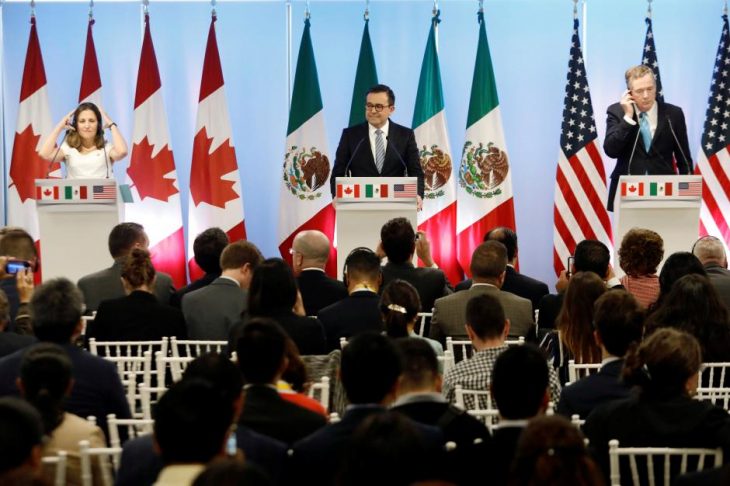- Objectives.
The idea of renegotiating NAFTA is not crazy. The original agreement came into force in 1994. The economy has changed a great deal in the 23 years since then. As but one example, there was essentially no electronic commerce when NAFTA launched. There has been a long-standing eagerness on the part of all three countries to update the agreement. The principal obstacle was the toxic prospect of getting a NAFTA 2.0 agreement through the U.S. congress.
Despite this obstacle, the Obama administration tried to renegotiate NAFTA. The Trans-Pacific Partnership trade deal that President Trump nixed in January included both Mexico and Canada and took on some key modernization issues, as well as making limited progress on complaints such as the lack of openness of Canada’s dairy market. Ultimately, of course, the TPP failed.
As a general rule, the more reasonable the Trump objectives, the better the prospects for a successful negotiation. Unfortunately, the early indications here are not good. The criticisms of NAFTA embodied in the draft Executive Order for withdrawal include claims that the agreement cost 700,000 jobs, damaged American manufacturing, and increased the trade deficit. Most economists would dispute those claims. Flawed diagnoses do not lend themselves to easy remedies. There is a lot that could be accomplished through new NAFTA talks, but the administration would need to rethink its assessment of the old agreement and set more realistic goals.
- Personnel
The American voting public was clearly beguiled by the idea that a master negotiator could swoop in and right all wrongs. This idea, no doubt, is reinforced by images of summits in which ministers or heads of state gather, bargain, and sign deals.
It’s an illusion. If there is any complexity to the issue at all, those leaders only finalize the work done by lower-ranking subject experts. As but one example, Canadian dairy restrictions – about which President Trump publicly complained – are exceedingly complex. Negotiations to address U.S. concerns will initially be conducted by an Assistant Secretary of Agriculture or Assistant United States Trade Representative (USTR) – a couple of levels below cabinet rank.
The problem is that President Trump has mostly not appointed these people, much less gotten them confirmed by the Senate. His Secretary of Agriculture, Sonny Perdue, was only confirmed last week. His nominee for USTR, Robert Lighthizer, has yet to be confirmed, though it now seems the partisan impasse over his nomination has been resolved. This is progress, but nowhere near the completion of a negotiating team. The United States may be months away from being staffed to renegotiate NAFTA.
- Constancy
Once a negotiating team is in place, they will face a prolonged task. It is common for such talks to take well over a year. The TPP talks started in fall 2008 and concluded in the fall of 2015!
To succeed across such an extended timeframe will require two qualities that have been in short supply in this administration – patience and constancy. Negotiators need to have set objectives and then be given time to work toward them. The early impression of the Trump administration is not one of convergence to a settled stance on trade, but rather a vacillation between two starkly different stances – the skepticism of the trade critics (e.g. Peter Navarro) versus the practicality of the more market-oriented members of the administration (e.g. Gary Cohn). Without more consistent direction from the White House, it will be very difficult for American negotiators to succeed.
- Congress
In fact, however unconstrained President Trump may feel, U.S. objectives in trade negotiations are already set by law – the Trade Promotion Authority legislation of 2015. Those Congressional objectives seem, at best, loosely connected to the stated intentions of the Trump administration.
This matters because trade agreements are worth little or nothing without the approval of Congress (as the Obama administration discovered to its chagrin with TPP). The U.S. Constitution (Article 1, Section 8) gives Congress control over trade. Negotiations with any prospect of success will not be driven primarily by a president’s preoccupations on trade, but rather by the necessity to command majority support in the House and Senate. As the Trump administration has discovered on health care and tax reform, winning those majorities can be exceedingly difficult. It may well discover, in the future, that this was yet another argument in favor of multilateral agreements like the TPP – they limit the number of times a bill needs to be laboriously pushed through Congress.
Beyond the challenges posed by these four factors, it gets worse. A clock is ticking; Mexico holds presidential elections in July 2018. Given the shortcomings of the administration’s Mexican diplomacy to date, that may mark the closing of a window for dealing with a cooperative partner. The Trump administration does not yet seem poised for success in new talks with Mexico and Canada. While renegotiation is distinctly preferable to NAFTA dissolution, the administration is simply not ready.



